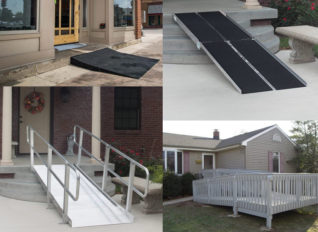Wheelchair ramps, power wheelchair ramps and mobility scooter ramps are available in a number of different styles to accommodate capabilities, weather, structures, etc. Selecting the wheelchair or scooter ramp that’s right for you requires careful consideration of a number of factors, including:
- Ramp use – threshold, steps, raised landing, vehicle, etc.
- Space available for the ramp
- Installation type – permanent, semi-permanent or a temporary (these can also be portable)
- Total weight and size that needs to be accommodated – equipment and people
- Surface type of ramp – this varies based on indoor or outdoor use as well as geographic location (an outdoor location that gets a lot of rain or snow would be best served by a ramp with an open, grid surface)
- Slope of ramp or how high it will need to rise
- Storage options – depends on if you have space for a single piece ramp or if the ramp needs to be foldable (consider if storing at home, work or in a vehicle)
Determining Length Wheelchair Ramps or Scooter Ramps
The ADA recommends a 1:12 slope, one foot of ramp for every inch of vertical rise, if you will ride up and down the wheelchair ramp while seated. If you will be walk the wheelchair up the ramp, a 1:3 slope or 1 inch of ramp for every 3 inches of vertical rise.
Minimum ADA Requirements for a Ramp
- 5’ x 5’ landing at top and bottom of ramp
- No more than 30’ before a turn or platform
- At least 36” wide
- 34” high handrails
NOTE: Wheelchair camber should be taken into consideration when selecting a wheelchair ramp as it might require extra width.
Get more information about ADA standards for ramps and curb ramps. (PDF)
This guide includes a number of illustrations that detail the specifications for ramp installation as well as information about where ramps and curb ramps are required, slopes, widths, rise, landings, doorways at landings, handrails and more.


Leave a Reply